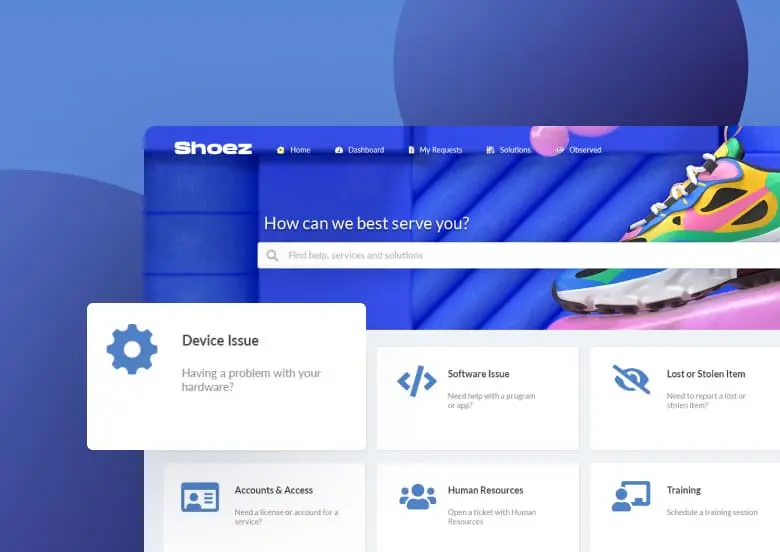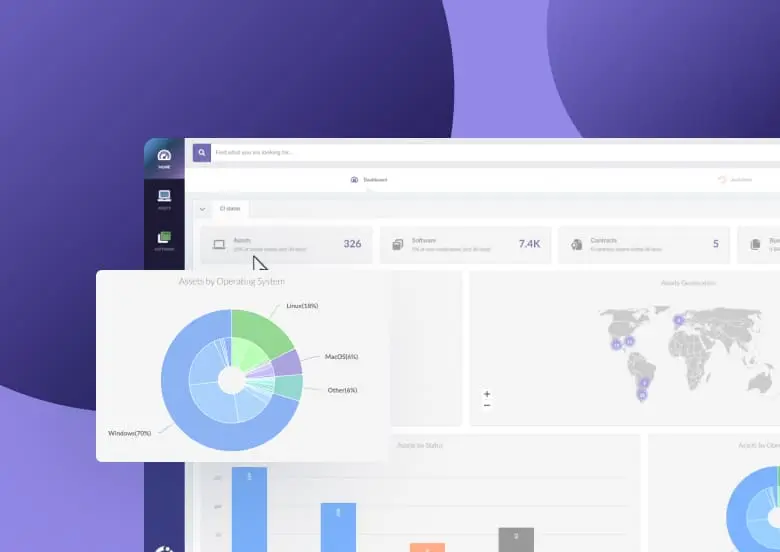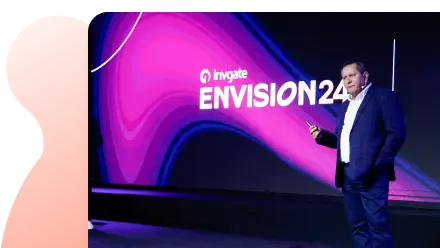Organizing IT support is already challenging enough, and relying on email as your main communication tool only makes it harder. No matter how many tags you set up or how detailed your guidelines are, email just isn’t built for this kind of work, making it tough to maintain order. Fortunately, an email ticketing system can address most of these issues.
We’ve seen clients all over the world who cannot properly track their agents’ performance, miss requests, and waste valuable time in an effort to make emails do something they were not meant to.
But there’s hope because a ticketing system like InvGate Service Management can help you keep track of support requests and ensure that each one is addressed on time.
It’s a lifesaver if you're struggling to stay on top of customer support requests. By organizing and automating your email communications, you will manage customer inquiries more efficiently and improve your overall support process.
And, in case you were wondering, we’ll tell you exactly how in this article. Dive with us into the world of email ticketing systems, their benefits, key features, and providers!

What is an email ticketing system?
An email ticketing system is a software application (usually in the form of a help desk) that helps businesses manage customer support requests. It allows customers to submit help requests via email and then tracks and organizes those requests throughout their lifecycle in a central place. This makes it easier for support staff to resolve incidents and problems promptly.
As you can see, the beauty of a ticketing system is that the only part of the company aware of the change is the IT department, meaning that you won’t have to change the organizational culture to adopt the new tool.
5 disadvantages of using email for IT support
Without a system in place, email management can quickly become chaotic. Email support requests can quickly build up in the inbox and become overwhelming, especially for busy IT departments. And the worst part: they can easily fall through the cracks and, in some cases, prolong the problem-solving process.
If you're still not sure if switching to a customer support ticketing system is worth it, some of our clients’ problems before making the switch might resonate with your current system:
- Email requests can get lost in the shuffle. Without a dedicated system for tracking and managing support requests, it can be easy for them to slip through the cracks. This is especially true if multiple people are CC'ed on the email chain, or if there’s only one support email inbox for the whole team.
- Email is not always the most efficient way to resolve technical issues. In some cases, it might actually prolong the problem-solving process. For example, if a complex issue requires troubleshooting or back-and-forth communication, it might be better to pick up the phone or jump on a video call instead.
- Email support can create a backlog of requests. If your IT team is already dealing with a high volume of email requests, it can be tough to keep up. This can lead to a backlog of requests, which can be frustrating for both customers and support agents.
- Email support can be hard to scale. As your business grows, you might find that email is no longer the most efficient way to handle support. At this point, you might need to consider investing in a dedicated ticketing system or help desk software.
But how does a Ticket Management system perform against these pain points? We'll cover that in the following section.
5 benefits of an email ticketing system
If you want to really ensure your customer service is delivering value, an email ticketing system is the right solution to avoid these challeges.
That was the case of one of our clients, Harmony Public Schools, as was stated by their Service Desk Manager after implementing InvGate Service Management:
|
|
Martin Nuñez |
Without a doubt, increased visibility is key to reducing your ticket backlog. But it doesn't stop there. Let's see some other benefits of using an email ticketing system for customer support:
- It can help you keep track of all customer inquiries in one place, minimizing human error and improving first-response times.
- Email ticketing systems often include features like auto-responders and email notifications, which improve the efficiency of your support process.
- Many email ticketing systems offer reporting tools to help you track customer support ticket trends. This information will help you to make decisions about how to improve your customer service process. They can also guide you on how your team is performing.
- End-users don’t need to use the platform to contact IT support, making this a low-friction change that only impacts your IT team.
- Self-service options can help to reduce the number of calls made to the support team, freeing up time to deal with other issues.
Top 5 best email ticketing systems
There are many email ticketing systems on the market, so choosing one that's right for your business is essential. To help you decide, we've compiled a list of the top five email ticketing systems.
InvGate Service Management makes email ticketing simple and efficient. It automatically turns customer emails into tickets, ensuring every request is tracked and addressed. Tickets can also be assigned automatically based on set rules like the type of request or customer location, helping teams respond faster without extra manual work.
Agents have all the tools they need to handle tickets, with clear dashboards and full visibility into each request. For managers, real-time reports provide a quick overview of team performance, making it easy to spot what’s working and what needs improvement. InvGate also supports self-service options, letting customers find answers on their own, which helps cut down on emails and saves time.
If your team grows or you want to expand beyond email, features like automated workflows can simplify handling different types of requests. With everything designed to make support smoother, InvGate is a great fit for improving email-based support for businesses of all sizes.

2- Zendesk
Zendesk is one of the most popular email ticketing systems on the market. It automates ticket creation from incoming emails, allowing support teams to manage inquiries efficiently. It features intelligent routing that assigns tickets to the most suitable agents based on predefined criteria.
Zendesk is known for its extensive integrations and advanced customization options, making it a strong choice for large organizations. However, it might be less ideal for smaller teams due to its high pricing and the technical expertise required to manage integrations and customizations.
3- Freshdesk
This is another popular email ticketing system. It offers many of the same features as Zendesk. It includes ticket conversion, automatic assignment, and self-service options. It offers customizable dashboards and basic reporting tools, though some users find the new reporting system overly complex and less user-friendly compared to its predecessor.
Reviews highlight the need for improved analytics and easier data export options. Despite these concerns, it remains a popular choice for small to mid-sized teams.
4- Help Scout
Help Scout is an email ticketing system that's growing in popularity. It stands out for its simplicity and personalized customer management features. Its user-friendly interface makes it easy for teams to learn and use effectively. However, it has some drawbacks, including limited integrations and the absence of advanced analytics.
5- Zoho Desk
Zoho Desk is a cloud-based email ticketing system that helps businesses streamline their customer support operations. It provides a wide range of features for ticket management and automation. Despite its potential, users have noted that the platform has a steep learning curve, which can slow down onboarding and initial use for teams unfamiliar with such tools.

Ticket Handling Best Practices: Reduce Backlog And Boost Performance
7 must-have features to look for in email ticketing software
Every ticketing system needs certain features to be effective. These features include converting tickets, automatically assigning tickets, providing a self-service knowledge base, offering real-time reporting, and creating workflows.
1. Ticket conversion
One of the essential features of a ticketing system is the ability to convert tickets. This feature allows you to take a customer email and convert it into a ticket. This is essential because it helps to organize your support and ensures that each customer request is handled promptly.
2. User experience

A great email ticketing system must have a great user experience. This means that it should be easy to use and have all the features that your agents need, such as clear dashboards and a complete request view of each incoming ticket.
On the admins’ side, an optimized user experience should also include reports and metrics – so they can understand what’s going on with their team at a glance – and features that ease the day-to-day job.
But also, if you one day decide to implement the help desk software as a platform for the rest of the company (and move away from emails), you need to ensure that the tool your agents are already using also has a great customer experience for a smooth adoption, especially for users who are not tech-savvy.
That was actually the problem of another client of ours, EfectivoSí. This Argentine financial services company had two failed attempts at implementing a help desk tool before choosing InvGate Service Management.
But once they did it, they were able to leave behind emails and phone calls as support channels. Now, more than 99% of requests are submitted via self-service, and since other teams didn’t take long to see the value of our tool, they have built 22 different help desks so far to expand the platform to other areas of the company.
3. Follow-up conversations
As anyone who has ever dealt with customer service can attest, one of the most important features of an email ticketing system is the ability to have a conversation with the customer. This means that when an email comes in, an agent can respond, and their next response updates the ticket. It is essential for keeping track of the conversation and ensuring that nothing falls through the cracks.
It also helps to create a more personal connection with the customer, which can help diffuse tense situations.
4. Automatic ticket assignment
Another key feature of a ticketing system is the ability to assign tickets automatically. Though you might want to start assigning tickets manually until everyone is comfortable with the tool, once you get the hang of it, you’ll want to start automating things. And this is one of the easiest ones to start with.

InvGate Service Management allows you to choose among three different rules to auto-assign tickets, so they are routed to the appropriate team or individual based on predefined criteria, such as the type of inquiry, the customer's location, or the product they are using.
This can help ensure that tickets are handled promptly and efficiently, reducing response times by eliminating the need for manual routing of tickets.
5. Self-service knowledge base
Following the spirit of getting used to the tool, you’d want to have a self-service knowledge base on your side. Once your new procedures are in place, your agents will be able to start creating articles to let customers find answers to questions without having to contact support. This can reduce the number of support email requests, save time and money, and increase customer satisfaction. With a self-service knowledge base, customers can find answers to questions quickly and easily.
With a knowledge base, you can quickly resolve support issues without relying on email back and forth.

6. Real-time reporting
This allows you to see how your support is performing and identify areas that require improvement. This is valuable when you need to track response times or identify patterns in customer inquiries.
7. Workflows
Workflows allow you to automate your support process and make sure that each ticket is handled consistently. They are a great way to keep your support organized. By creating different workflows for different requests, you can ensure that each request is routed to the right person or team.
For example, you might have a workflow for bug reports, another for feature requests, and another for general questions. Each workflow can have its own rules, so requests are automatically sorted and assigned as they come in.
Sounds fancy? That’s because it is! But don’t worry, it doesn’t require a lot of hard work. Plus, you only have to configure it once, and once workflows are up and running, they can help take some guesswork out of support. By routing requests efficiently, you can resolve them more quickly and improve the overall quality of your support.
But since it’s easier said than done, we have a quick video to show you how to do it in our very own InvGate Service Management. With InvGate, you’ll start by creating tickets from email messages with just a few clicks, but that’s so simple that you’ll be quickly looking for what else to improve. And you’re in luck because it has some other cool features to streamline your support operations.
6 advantages of moving from an email-based ticketing system to a help desk
Switching from an email-based ticketing system to a dedicated help desk can significantly enhance your support team's efficiency and improve the overall customer experience. Here’s why upgrading makes sense:
- It’s easier than you think: A help desk is easy to implement and use. With intuitive interfaces, teams can quickly transition to the platform and begin providing better customer support without lengthy onboarding processes.
- You will increase customer satisfaction: with a ticket system, your customers can get the help they need, when they need it. Actually, a 2021 report from HappySignals pointed out that employees are losing less time per ticket when using service portals than email as a channel for IT support services.
- Because there is never enough feedback: Help desk software helps you collect customer feedback. Tracking inquiry trends can reveal product or service improvement opportunities, helping your business address customer needs effectively.
- Trustworthy metrics: Unlike email, help desks offer robust reporting tools. You can monitor metrics like ticket volume, response times, and resolution rates, providing a clear view of team performance and areas for improvement. These insights help you measure your support quality accurately.
- You can improve productivity and teamwork: A centralized ticketing system organizes requests, bugs, and issues into manageable queues. Teams can prioritize effectively, track progress, and identify recurring problems more easily. Collaborative tools within help desks ensure smoother communication and faster resolution times.
- Because time is also money: According to HDI the cost of resolving a ticket can range from as little as $6 to over $40. Where your costs fall within this range depends on several factors, with time to resolution being one of the most significant. Help desks often include features like automated responses, workflows, and escalation rules, which reduce repetitive tasks and free up your team's time.
Key takeaways
The impact of exceptional customer service on a company's growth and success is significant.
That's where an email ticketing solution can be helpful. It's a cost-effective and robust method for offering outstanding customer service while being sustainable and scalable.
Even if you start by integrating your email provider with it, later on, you can take the time to look into some other features that might not be your priority today, but that will make a difference in the support your team provides.
So, when you search for an email ticketing software, make sure it has:
- An intuitive UX to avoid long training sessions.
- A short implementation time, so you can have it up and running as soon as possible.
- A provider with ongoing customer support, so you can get in touch at any point.
- Extra features like a self-service portal, automatic ticket assignment, and workflow automation ensure you avoid a migration when your company grows.
Implementing an email ticketing system is a one-way trip; there’s no looking back. And the best thing is that you can try it yourself for free. Yes, you read it right. You can request our 30-day free trial, integrate it with your email provider by following the above video, and see it in action.

















